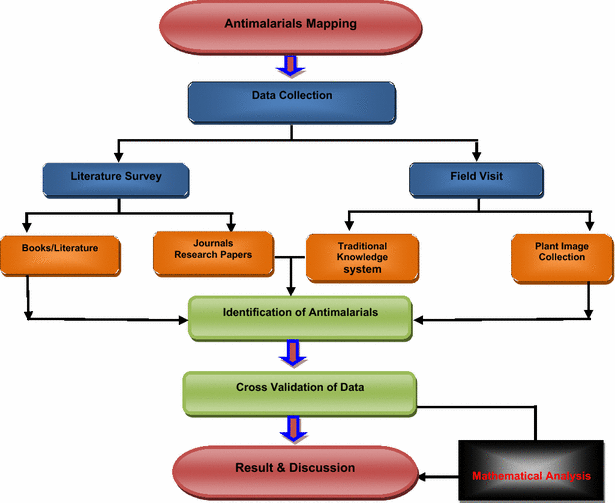Ethnobotanical perspective of antimalarial plants: traditional knowledge based study
- PMID: 26847459
- PMCID: PMC4743172
- DOI: 10.1186/s13104-015-1827-z
Ethnobotanical perspective of antimalarial plants: traditional knowledge based study
Abstract
Background: Considering the demand of antimalarial plants it has become essential to find and locate them for their optimal extraction. The work aims to find plants with antimalarial activities which were used by the local people; to raise the value of traditional knowledge system (TKS) prevalent in the study region; to compile characteristics of local plants used in malaria treatment (referred as antimalarial plants) and to have its spatial distribution analysis to establish a concept of geographical health.
Methods: Antimalarial plants are listed based on literature survey and field data collected during rainy season, from 85 respondents comprised of different ethnic groups. Ethno-medicinal utilities of plants was extracted; botanical name, family, local name, part used, folklore, geographical location and image of plants were recorded after cross validating with existing literatures. The interview was trifurcated in field, Vaidya/Hakims and house to house. Graphical analysis was done for major plants families, plant part used, response of people and patients and folklore. Mathematical analysis was done for interviewee's response, methods of plant identification and people's preferences of TKS through three plant indices.
Results: Fifty-one plants belonging to 27 families were reported with its geographical attributes. It is found plant root (31.75 %) is used mostly for malaria treatment and administration mode is decoction (41.2 %) mainly. The study area has dominance of plants of family Fabaceae (7), Asteraceae (4), Acanthaceae (4) and Amaranthaceae (4). Most popular plants found are Adhatoda vasica, Cassia fistula and Swertia chirata while % usage of TKS is 82.0 % for malaria cure.
Conclusion: The research findings can be used by both scientific community and common rural people for bio-discovery of these natural resources sustainably. The former can extract the tables to obtain a suitable plant towards finding a suitable lead molecule in a drug discovery project; while the latter can meet their local demands of malaria, scientifically.
Figures
Similar articles
-
Ethnopharmacobotanical study on the medicinal plants used by herbalists in Sulaymaniyah Province, Kurdistan, Iraq.J Ethnobiol Ethnomed. 2016 Jan 28;12:8. doi: 10.1186/s13002-016-0081-3. J Ethnobiol Ethnomed. 2016. PMID: 26821541 Free PMC article.
-
Ethnobotanical survey of medicinal plants used in the treatment of malaria in Ogbomoso, Southwest Nigeria.J Ethnopharmacol. 2013 Oct 28;150(1):71-8. doi: 10.1016/j.jep.2013.07.038. Epub 2013 Aug 3. J Ethnopharmacol. 2013. PMID: 23920250
-
Ethnobotanical study of medicinal plants used for the treatment of malaria in plateau of Allada, Benin (West Africa).J Ethnopharmacol. 2013 Mar 7;146(1):154-63. doi: 10.1016/j.jep.2012.12.022. Epub 2012 Dec 22. J Ethnopharmacol. 2013. PMID: 23266332
-
Antimalarial activity of medicinal plants from the Democratic Republic of Congo: A review.J Ethnopharmacol. 2015 Jul 1;169:76-98. doi: 10.1016/j.jep.2015.03.075. Epub 2015 Apr 8. J Ethnopharmacol. 2015. PMID: 25862959 Review.
-
Plants used to treat malaria in Nyakayojo sub-county, western Uganda.J Ethnopharmacol. 2011 Sep 1;137(1):154-66. doi: 10.1016/j.jep.2011.05.002. Epub 2011 May 6. J Ethnopharmacol. 2011. PMID: 21575702 Review.
Cited by
-
Harnessing the application of halophytic flora biomass in the management of healthcare of local people in the Salt Range of Punjab.Sci Rep. 2025 Jun 4;15(1):19685. doi: 10.1038/s41598-025-00961-z. Sci Rep. 2025. PMID: 40467629 Free PMC article.
-
Plants as Sources of Natural and Recombinant Antimalaria Agents.Mol Biotechnol. 2022 Nov;64(11):1177-1197. doi: 10.1007/s12033-022-00499-9. Epub 2022 Apr 29. Mol Biotechnol. 2022. PMID: 35488142 Free PMC article. Review.
References
-
- Qayum A, Lynn A, Arya R. Traditional knowledge system based GIS mapping of antimalarial plants: spatial distribution analysis. J Geogr Inf Syst. 2014
-
- National Vector Borne Disease Control Programme: Malaria situation in India. Ministry of Health and Family Welfare, Delhi. Govt. of India. http://www.nvbdcp.gov.in/Doc/malaria1.pdf.
-
- Qayum A, Lynn AM, Arya R, Jaiswal SK. GIS integrated epidemiological indices for risk area identification towards malaria control measures. IJEAT. 2013;2(6):376–381.
-
- National Vector Borne Disease Control Programme: Guidelines for diagnosis and treatment of malaria in India 2009.
Publication types
MeSH terms
Substances
LinkOut - more resources
Full Text Sources
Other Literature Sources




